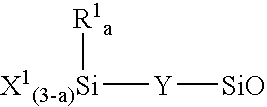Room temperature-curable organopolysiloxane composition
a technology of organopolysiloxane and composition, which is applied in the field of room temperature cureable organopolysiloxane, can solve the problems of difficult adhesion of resins to conventional sealants, and insufficient adhesion to resins, and achieve excellent adhesion, reduce workability, and increase the viscosity of materials
- Summary
- Abstract
- Description
- Claims
- Application Information
AI Technical Summary
Benefits of technology
Problems solved by technology
Method used
Image
Examples
example 1
[0038]To a mixture of 100 parts by weight of polydimethylsiloxane endcapped with trimethoxysiloxy group having a viscosity at 23° C. of 50,000 mPa·s and 100 parts by weight of polydimethylsiloxane endcapped with trimethoxysiloxy group having a viscosity at 23° C. of 5000 mPa·s were added 90 parts by weight of colloidal calcium carbonate surface treated with a fatty acid ester (specific surface area 20 m2 / g), 110 parts by weight of surface-untreated heavy calcium carbonate (specific surface area 4 m2 / g), and 2 parts by weight of fumed silica which had been surface treated with dimethylchlorosilane, and the mixture was mixed in a blender. To this mixture, 3 parts by weight of methyltrimethoxysilane, 2.5 part by weight of diisopropoxybis(ethyl acetoacetate)titanium, and 0.5 parts by weight of a reaction product of γ-methacryloxy propyl trimethoxysilane and γ-aminopropyltrimethoxysilane and the mixture was fully mixed under reduced pressure to produce composition 1.
example 2
[0039]Composition 2 was obtained by using 100 parts by weight of polydimethylsiloxane endcapped with trimethoxysiloxy group having a viscosity at 23° C. of 50,000 mPa·s instead of the 100 parts by weight of polydimethylsiloxane endcapped with trimethoxysylethylene group having a viscosity at 23° C. of 30,000 mPa·s.
PUM
| Property | Measurement | Unit |
|---|---|---|
| specific surface area | aaaaa | aaaaa |
| specific surface area | aaaaa | aaaaa |
| temperature | aaaaa | aaaaa |
Abstract
Description
Claims
Application Information
 Login to View More
Login to View More - R&D
- Intellectual Property
- Life Sciences
- Materials
- Tech Scout
- Unparalleled Data Quality
- Higher Quality Content
- 60% Fewer Hallucinations
Browse by: Latest US Patents, China's latest patents, Technical Efficacy Thesaurus, Application Domain, Technology Topic, Popular Technical Reports.
© 2025 PatSnap. All rights reserved.Legal|Privacy policy|Modern Slavery Act Transparency Statement|Sitemap|About US| Contact US: help@patsnap.com



